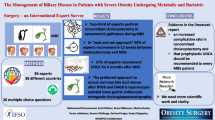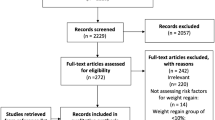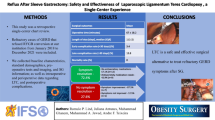Abstract
Purpose
Weight regain after Roux-en-Y gastric bypass (RYGB) is associated with worsening of liver outcomes. However, the effect of transoral outlet reduction (TORe) on liver fibrosis in RYGB patients with weight regain and possible advanced fibrosis remains unknown.
Materials and Methods
This was a retrospective analysis of prospectively collected data of RYGB patients who underwent TORe for weight regain. Only patients with possible advanced fibrosis were included. TORe was performed using either an endoscopic suturing device (S-TORe) or plication device (P-TORe) to reduce the gastrojejunal anastomosis (GJA) and pouch sizes. Primary outcomes included changes in non-invasive tests (NITs) for fibrosis at 6–12 months. Secondary outcomes included weight loss and changes in insulin resistance and lipid profile at 6–12 months.
Results
Fifty RYGB patients were included. Baseline age and BMI were 55 ± 11 years and 40.1 ± 7.3 kg/m2. Baseline GJA and pouch sizes were 20 ± 7 mm and 5 ± 2 cm, respectively. Thirty patients (60%) underwent S-TORe and 20 patients (40%) underwent P-TORe. At 12 months following TORe, there were statistically significant improvements in NITs for fibrosis, including ALT, AST and FIB-4. There was a trend towards significant improvement in liver stiffness measurement on transient elastography. Patients experienced 8.8 ± 11.2% total weight loss (TWL) (p < 0.0001), with 60% experiencing at least 10% TWL. Additionally, there was a significant improvement in HbA1c and a trend toward significant improvement in Homeostatic Model Assessment for Insulin Resistance (HOMA-IR), suggestive of improved insulin sensitivity.
Conclusion
TORe is associated with an improvement in hepatic fibrosis in patients with NAFLD and possible advanced fibrosis.
Graphical Abstract




Similar content being viewed by others
Data Availability
Informed consent is not applicable in this study.
Abbreviations
- TORe:
-
Transoral Outlet Reduction
- RYGB:
-
Roux-en-Y Gastric Bypass
- NAFLD:
-
Nonalcoholic Fatty Liver Disease
- EBMTs:
-
Endoscopic Bariatric and Metabolic Therapies
- S-TORe:
-
Transoral Outlet Reduction using Endoscopic Suturing Device
- P-TORe:
-
Transoral Outlet Reduction using Plication Device
- NITs:
-
Non-invasive tests
- GJA:
-
Gastrojejunal anastomosis
- TWL:
-
Total weight loss
- HSI:
-
Hepatic Steatosis Index
- FIB-4:
-
Fibrosis-4 Index
- APRI:
-
Aspartate aminotransferase to platelet ratio
- LSM:
-
Liver Stiffness Measurement
- IOP:
-
Incisionless Operating Platform
- APC:
-
Argon plasma coagulation
- ESD:
-
Endoscopic Submucosal Dissection
- PPI:
-
Proton Pump Inhibitor
- AST:
-
Aspartate aminotransferase
- ALT:
-
Alanine aminotransferase
- VCTE:
-
Vibration-controlled transient elastography
- HbA1c:
-
Hemoglobin A1c
- HOMA-IR:
-
Homeostatic Model Assessment for Insulin Resistance
- AEs:
-
Adverse Events
- ASGE:
-
American Society Gastrointestinal Endoscopy
- SD:
-
Standard Deviation
- BMI:
-
Body Mass Index
- NFS:
-
NAFLD Fibrosis Score
References
Cazzo E, Jimenez LS, Pareja JC, et al. Effect of Roux-en-Y gastric bypass on nonalcoholic fatty liver disease evaluated through NAFLD fibrosis score: a prospective study. Obes Surg. 2015;25(6):982–5. https://doi.org/10.1007/s11695-014-1489-2.
Sandvik ECS, Aasarød KM, Johnsen G, et al. The effect of Roux-en-Y gastric bypass on non-alcoholic fatty liver disease fibrosis assessed by FIB-4 and NFS scores-an 11.6-year follow-up study. J Clin Med. 2022;11(16):4910. https://doi.org/10.3390/jcm11164910.
Zenténius E, Andersson-Assarsson JC, Carlsson LMS, et al. Self-reported weight-loss methods and weight change: ten-year analysis in the Swedish Obese Subjects Study Control Group. Obesity (Silver Spring). 2018;26(7):1137–43. https://doi.org/10.1002/oby.22200.
Jimenez LS, Mendonça Chaim FH, Mendonça Chaim FD, et al. Impact of weight regain on the evolution of non-alcoholic fatty liver disease after Roux-en-Y gastric bypass: a 3-year follow-up. Obes Surg. 2018;28(10):3131–5. https://doi.org/10.1007/s11695-018-3286-9.
Jirapinyo P, Kumar N, AlSamman MA, et al. Five-year outcomes of transoral outlet reduction for the treatment of weight regain after Roux-en-Y gastric bypass. Gastrointest Endosc. 2020;91(5):1067–73. https://doi.org/10.1016/j.gie.2019.11.044.
Zhou JH, Cai JJ, She ZG, et al. Noninvasive evaluation of nonalcoholic fatty liver disease: current evidence and practice. World J Gastroenterol. 2019;25(11):1307–26. https://doi.org/10.3748/wjg.v25.i11.1307.
Jirapinyo P, Kröner PT, Thompson CC. Purse-string transoral outlet reduction (TORe) is effective at inducing weight loss and improvement in metabolic comorbidities after Roux-en-Y gastric bypass. Endoscopy. 2018;50(4):371–7. https://doi.org/10.1055/s-0043-122380.
Dolan RD, McCarty TR, Jirapinyo P, et al. Endoscopic revision of gastric bypass using plication technique: an adjustable approach. VideoGIE. 2021;6(7):311–5. https://doi.org/10.1016/j.vgie.2021.04.001.
Nass KJ, Zwager LW, van der Vlugt M, et al. Novel classification for adverse events in GI endoscopy: the AGREE classification. Gastrointest Endosc. 2021. https://doi.org/10.1016/j.gie.2021.11.038.
Dayan D, Kuriansky J, Abu-Abeid S. Weight regain following Roux-en-Y gastric bypass: etiology and surgical treatment. Isr Med Assoc J. 2019;21(12):823–8.
Rinella ME, Neuschwander-Tetri BA, Siddiqui MS, et al. AASLD Practice Guidance on the clinical assessment and management of nonalcoholic fatty liver disease. Hepatology. 2023;77(5):1797-1835. https://doi.org/10.1097/HEP.0000000000000323
Funding
None.
Author information
Authors and Affiliations
Contributions
A.J.: Data collection, statistical analysis, manuscript preparation.
C.T.: Patient recruitment, performing procedures and follow-ups and critical review of the manuscript.
P.J.: Study design and concept, patient recruitment, performing procedures and follow-ups, data collection, statistical analysis, manuscript preparation, critical review of the manuscript.
Corresponding author
Ethics declarations
Informed Consent
Informed consent was obtained from all individual participants included in the study.
Human and Animal Rights
For this type of study formal consent is not required.
Conflict of Interests
A.J. has no conflict of interest. C.T. has served as a consultant for Apollo Endosurgery, Boston Scientific, Enterasense, EnVision Endoscopy, Fractyl, USGI Medical, Medtronic/Covidien, Olympus/Spiration and GI Dynamics, has served as an advisory boards member for USGI Medical and Fractyl, has received research grant and support from USGI Medical, Apollo Endosurgery, Boston Scientific, ERBE, FujiFilm, Lumendi Olympus/Spiration, Aspire Bariatrics and GI Dynamics, has served as a general partners for Blueframe Healthcare, has served as a founder for Enterasense, EnVision Endoscopy and GI Windows, and holds stock and royalties for GI Windows. P.J. has received research support from Apollo Endosurgery, Boston Scientific, Fractyl, GI Dynamics and USGI Medical, has served as a consultant to Apollo Endosurgery, ERBE, GI Dynamics and Spatz Medical and has received royalty from Endosim.
Additional information
Publisher's Note
Springer Nature remains neutral with regard to jurisdictional claims in published maps and institutional affiliations.
Key Points
- Weight regain following RYGB is associated with worsening NAFLD.
- Transoral outlet reduction (TORe) is associated with not only clinically significant weight loss but also improvement in hepatic fibrosis in patients with NAFLD and possible advanced fibrosis.
- There was a trend towards the improvement of insulin sensitivity after TORe.
Rights and permissions
Springer Nature or its licensor (e.g. a society or other partner) holds exclusive rights to this article under a publishing agreement with the author(s) or other rightsholder(s); author self-archiving of the accepted manuscript version of this article is solely governed by the terms of such publishing agreement and applicable law.
About this article
Cite this article
Jaroenlapnopparat, A., Thompson, C.C. & Jirapinyo, P. Effect of Transoral Outlet Reduction on Hepatic Fibrosis in Roux-en-Y Gastric Bypass Patients with Weight Regain and Non-alcoholic Fatty Liver Disease. OBES SURG 33, 2303–2310 (2023). https://doi.org/10.1007/s11695-023-06668-2
Received:
Revised:
Accepted:
Published:
Issue Date:
DOI: https://doi.org/10.1007/s11695-023-06668-2




